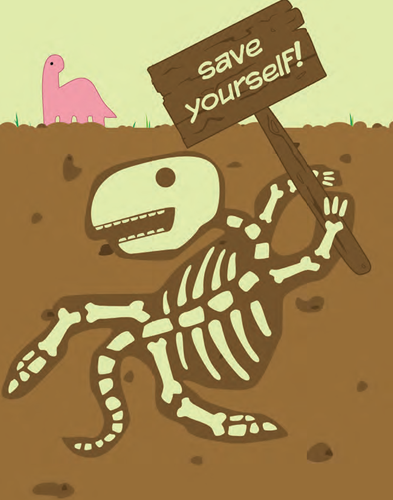Trivia

It is a widely accepted scientific c theory that Dinosaurs became extinct when a giant asteroid collided with the planet 65 million years ago. Their sheer size and the huge amount of food resources that these huge herbivore and carnivorous Dinosaurs needed had led them to become the dominating species on the planet. The massive emissions of CO2 and Methanol that resulted from the collision of the asteroid caused a global environmental disaster and the extinction of more than half of the species on Earth, those that were incapable of adapting. As a result other mammals started to emerge from the shadows and the foundations were laid for humans to become the new dominating species on the planet.
Back to the present day, and despite the still modest progress achieved at the various Climate Summits that have been held, it is a widely accepted scientific consensus that the greenhouse effect resulting from gas emissions is the cause of global warming and climate change and that a proactive and well thought out strategy to adapt to climate change must be sought to avoid the catastrophic effects on world populations and economies.
It is also a generally accepted fact that a reduction of emissions can be achieved by dramatically reducing the use of fossil fuels to produce electricity, for industry and in particular, for transport. Fossil fuels can be replaced by using renewable sources of energy replenished in nature, such as the sun, wind, water and geothermal resources, and by using biofuel from energy cultures such as corn, cereals, sugar beetroot, sugar cane and oil-rich plants.
Environmental agencies have argued that, in order to meet this accelerating demand for biofuels, and validated by the EU1 environmental policy, amongst other initiatives, energy based cultures are usually characterized by single crop farming, and very often on land that was previously occupied by forests capable of absorbing high quantities of CO2 from the atmosphere and whose emissions it is so important to keep down. This intensive farming also uses vast water resources and contributes to a decline in biodiversity. In addition, it contributes to a reduction in availability of farming products and leads to an increase in pricing, thus making it harder for populations to ensure balanced diets and their ability to meet basic survival requirements.
As such, to merely replace the use of fossil fuels with an equally intensive use of biofuels to produce energy for industry and transport, in order to reduce greenhouse gas emissions is not a viable alternative as it does not promote sustainable development. It does not promote a change in consumption patterns or an increase in energy efficiency. Inefficient use of energy and natural resources are at the heart of the problem as well as the poor use that is made of emissions and waste products.
Efficient use of renewable energy from natural resources should be complemented by a sustainable approach to maximizing the protection of natural resources and their appropriate transformation before they are returned to the environment. Particular focus should be placed on solid waste and gas emissions as a source of value2 and not just as an irreversible source of damage to the environment.
It is clear that during economic downturns, even a small glimpse of a "green shoot”3 can lead to some very aggressive and unscrupulous initiatives that fall back on an intense and inefficient use of resources and energy and increase the level of waste and pollution. This can lead to very short sighted views of the economy, which promote quick and lucrative results from trading toxic waste and emissions, going totally against the underlying principles behind the green economy and so called environmental industries.
Sustainable development aims to manage emerging risks, which could actually turn out to be opportunities and don’t necessarily have to be giant leaps4 towards the abyss.
In conclusion, it is critical to embrace an Adaptation Strategy5, to develop new communities of interests and sustainable businesses, which openly behave in a socially responsible6 manner and are aligned with standards of corporate responsibility. Global interests must be shared and regulated according to the interests of the various stakeholders and according to legal regulation and international standards of conduct. This attitude will contribute to a more sustainable and efficient management of energy, the earth and water, waste management and protect biodiversity. Science and technology may also provide very important innovations to develop new solutions for humanity.
With the "beginning of the end” of business as usual, Transition Initiatives are required. New horizons and challenges are appearing in emerging risk coverage, and it is necessary to rethink the foundations of the insurance business, of sustainable risk evaluation, prevention and transferal in order to adapt to new adversities arising today and in the future. This will depend on the availability of information regarding catastrophe coverage, and on the ability to develop risk management models by using solutions and models adapted to the specific risk exposure of each situation.
Given this emergence, we are not very likely to see the return and survival of dinosaurs, mainly due to their appetite for available resources and their obvious difficulty in adapting to behavioural change, which ultimately led to their extinction. It remains to be seen whether, due to either distraction or to repeated tolerance regarding unsustainable habits, we are contributing to the emergence from the shadows of new earthly creatures, somewhat more frugal, and which are better equipped to deal with the need to adapt and to become the next dominating species on the planet.
By Pedro Castro Caldas, Risk Management Consultant
By Pedro Castro Caldas, Risk Management Consultant
1 The EU established an objective for renewable energy to increase the use of biofuels in the transport sector, as long as they were sourced in a sustainable manner.
2 Namely in RDF (Refuse Derived Fuel) production.
3 An analogy to spring shoots, an expression to indicate the end of a recession and used by Ben Bernanke, Chairman of the North American Federal Reserve in 2009 when a few fragile improvements were starting to appear in the context of the recession.
4 "The Great Leap” was a policy put into practice in 1958 aimed at making China a leading worldwide exporter, establishing almost impossible production targets. The Chinese regime still calls this a natural disaster. British Historian, Frank Dikottër claims that this was one of the largest mass murders in the history of humanity as the Great Leap Forward led to at least 45 million deaths in four years. (Mao´s Great Famine - The history of China´s most devastating catastrophe 1958-1962).
5 "Adaptation Strategy” is the name given by the EU to the phased adjustment to the impact of climate change, and which is complementary to member state actions in this field.
6 Guide to Social Responsability (ISO 26000/NP 4469-1): an organization’s responsibility for the environmental and social impact of its decisions and operations, guided by an ethical and transparent code of conduct.



